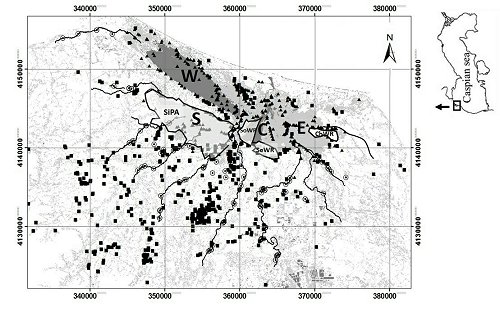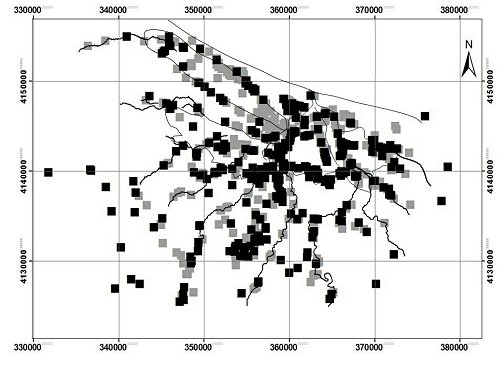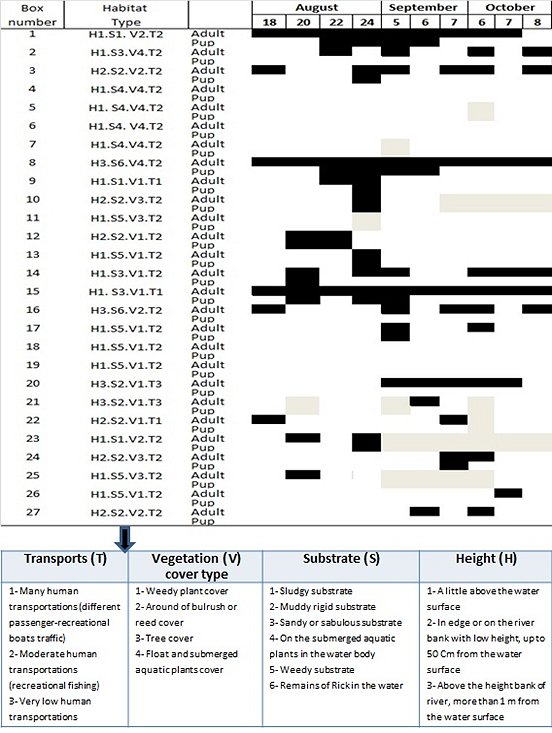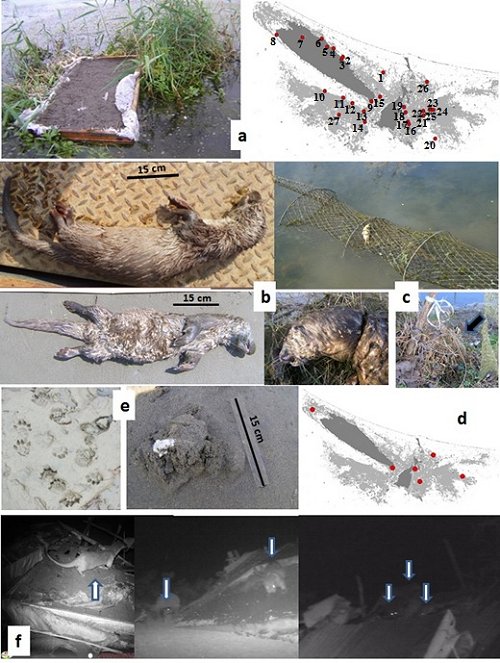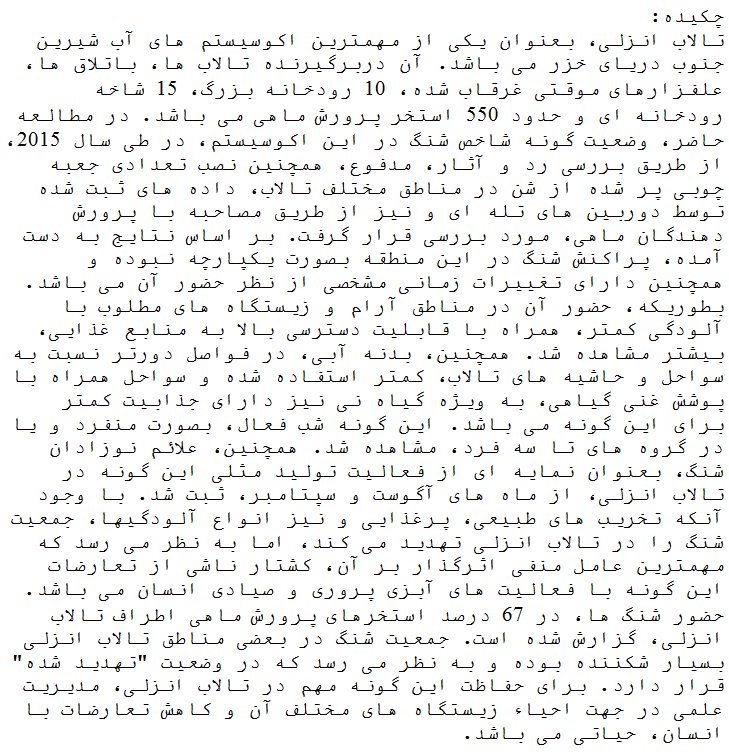IUCN/SSC Otter Specialist Group Bulletin

©IUCN/SCC Otter Specialist Group
Volume 34 Issue 2 (October 2017)
Citation: Naderi, S, Mirzahani, A and Hadipour, E (2017). Distribution of and Threats to the Eurasian Otter (Lutra lutra) in the Anzali Wetland, Iran. IUCN Otter Spec. Group Bull. 34 (2): 84 - 94
Distribution of and Threats to the Eurasian Otter (Lutra lutra) in the Anzali Wetland, Iran
Saeid Naderi1, Alireza Mirzajani2 and Ehsan Hadipour3
1Environmental Sciences Department, Natural Resources Faculty, University of Guilan, Iran e-mail: naderi@guilan.ac.ir (Corresponding Author)
2Inland Water Aquaculture Research Center, Iranian Fisheries Science Research Institute, Agricultural Research Education and Extension Organization (AREEO), Bandar Anzali, Iran
3 Guilan Provincial directorate of Department of Environment, Rasht, Iran



|
| (Received 19th April 2017, accepted 5th May 2017) |
| Download PDF (772 KB) |
| Abstract: The Anzali wetland, located in the south of the Caspian Sea, is considered as one of the most important freshwater ecosystems in that region. It consists of lagoons, marshes, temporary flooded grasslands, ten bigger rivers, fifteen tributary rivers and 550 fish farms. Throughout 2015, otters were surveyed there by searching for tracks and spraints, and also by using rafts, camera traps and interviews with fish farmers. Otter distribution was found to be not uniform and there are also obvious temporal changes of presence. It is more frequent in quiet and less polluted areas with enough food availability. Open water bodies aren't used away from the banks, and edges with weedy vegetation, particularly reeds, are not attractive to this species. These nocturnal animals were observed solitary or in groups of up to three individuals. Signs of otter pups, as the indicator of reproduction, were recorded in August and September. However, environmental degradation, eutrophication and other pollutants in the Anzali wetland threatens the Eurasian Otter population, but it seems that the most important negative factor is casualties caused by conflicts with fisheries and aquacultural activities. The presence of otters was reported by 67% of the fish pond owners around the Anzali wetland. The Eurasian otter population in some regions of the Anzali wetland is very fragile and it seems it is a "threatened" species there. Knowledgeable management of recovery of different habitats and decreasing conflicts with humans is crucial for conservation of this important species in the Anzali wetland. |
| Keywords: Anzali wetland, Distribution, Eurasian Otter, threat factors |
| Française | Español |
|
INTRODUCTION
The Eurasian Otter inhabits most rivers and wetland systems in Iran, but it does not mean the species has a high density (Kiabi, 1993; Ziaie and Gutleb, 1997; Mirzajani, 1999; Karami et al., 2006; Rasooli et al., 2007). This species was investigated in a few regions of Iran such as in Jajrood River of Tehran Province by Mirzaei et al. (2009), in the Dorfak region (Hamzehpour, 2006) and the Amirkelayeh wetland (Hadipour et al., 2011) of Guilan Province. Despite its important role in ecosystem functioning, there are many threats to this species. As a result, carcasses have been found in different regions. Illegal hunting has been observed for fur or taxidermy purposes (Hadipour et al., 2011); most recent conflicts between humans and otters are in relation to fishery activities and around fish farm ponds where many dead otters have been found (Mirzajani, 1999).
The Anzali wetland, as one of the most important freshwater ecosystem in the southern Caspian Sea, is confronted with many problems and negative factors (Mirzajani, 2009), and is listed in the Montreux record as priority site for conservation (Ramsar convention site). During a survey on identification and distribution of mammal fauna in the Anzali wetland (Naderi et al., 2016), the otter, as a top predator in this freshwater system, was extensively studied.
Here, the distribution of the Eurasian otter in the Anzali wetland water body and its main inlet rivers is reported as necessary data for formulation of conservation policies. Furthermore, fish farm ponds around the Anzali wetland have been surveyed, and the main threats for this species in theses areas are described. Also, in order to evaluate Eurasian otter conflicts in relation to human activities, the absence/presence of this species in fish culture ponds around the Anzali wetland and its watershed area was investigated.
MATERIALS AND METHODS
Study area
The Anzali wetland complex is comprised of large, shallow, eutrophic freshwater lagoons, shallow marshes and seasonally flooded grasslands. It extends north-west to south-east of the southwestern part of the Caspian Sea. It consists of four main sections: Siahkeshim, the eastern (Sheijan), the central, and the western parts (Fig 1; S, E, C and W). Area and depth of this complex is subject to seasonal variations of water. It covers an area of 19100 ha with 7000 ha of water body. The average water depth is less than 3 meters. The Anzali wetland acts as an ecotone between different ecosystems: terrestrial, the Caspian Sea, brackish and fresh water environments (Kimbal and Kimbal, 1974). Under DOE conservation management, there is one protected area (Siakeshim) and three wildlife refuges (Sorkhankol, Chokam and Selkeh).
The surface area of the Anzali wetland watershed is about 374000 ha with a large number of creeks and rivers. The combined river branches in the highlands form ten rivers in middle altitudes, including Chafroud, Bahambar, Morghak, Masal, Palangvar, Masoolehroodkhan, Pasikhan, Siahdarvishan, Lakanroud and Siahroud (NGO-IRAN, 2003). These rivers are split into many tributaries passing through urban and agricultural areas. Ultimately, fifteen tributary rivers flow into the Anzali wetland complex, while five canals discharge the water directly into the Caspian Sea. The total amount of sediment carried to the wetland is reported to be 390,000 tons/year (Mirzajani, 2009).
Approach
In this study, different parts of the Anzali wetland complex were seasonally patrolled from January 2015 to December 2015 using a speed boat. More than 250 points in the water bodies that make up the Anzali wetland were searched for all signs of otter including spraints, footprints, soil displacement and grooming and rolling areas. In particular, small rocks, heaps of mud and sand, tree trunks, piles of plants, and artificial materials such as cardboard and plastic were carefully examined for spraints.
The survey was obstructed by vegetation growth in spring and summer, so twenty-seven wooden boxes (rafts) were manufactured and installed in different habitats in the Anzali wetland in mid-August (Table 1, Fig. 3a). All rafts were filled with very soft sandy soil, so that the tracks of even the lightest individuals could be recorded. The review and investigation of the rafts was done during successive days, from 18 to 24 August, 5 to 7 September, and from 6 to 8 October. Furthermore, Eurasian otter behavior was studied in different parts of Anzali wetland by installing camera traps.
More than 80 other locations were searched for all signs of otter, along the main inlet rivers to the wetland, and about 200-1000 meters along river bank in each location.
According to archived data from the Guilan fisheries organization, about 550 fish farms with a surface area of 2450 hectares have been listed in the Anzali wetland catchment area. About 50% of fish farms were randomly searched for otter signs, and further information was obtained through interviews with fish farm owners. All surveyed fish ponds were inside the city boundaries of Anzali, Rasht and Somesara (Fig. 1).
RESULTS
According to a variety of observed parameters, Eurasian otters are present in the different parts of Anzali wetland. However, the distribution is not uniform in the different seasons in all parts of Anzali wetland (Fig. 2). While many regions such as shore lines, canals or rivers banks were used periodically, others including open water bodies away from the banks and edges with weedy vegetation were not occupied by this species. The rafts installed in this study not only showed the temporal distribution of adults (Table 1), but also indicated the presence of young otters (Fig. 3a). Permanent presence of otters was observed in some regions such as a destroyed hunting lodge in the western part (raft 8), in the grasslands of the Siahkeshim protected area (raft 27), in the central part (raft 14) and also in the eastern part (raft 23).
Some other regions (indicated by results from rafts 2 and 3 in the western part) are temporary habitats for otters. The open water far away from the banks, such as the rafts 4, 5 and 6 in the Western part, were not used by this species.
The maximum distance of spraints from open water was about 360 meters. No otter signs or tracks were observed on some rafts that had been installed in weedy vegetation at the water's edge (rafts 10 to 13, 18 and 19).
Based on the different data obtained (footprints, spraints), the presence of otter pups was confirmed particularly in August but also September. Furthermore, one female carcass found at the end of August showed clear signs of lactation.
The camera trap data (photos and movies) showed that otters in the Anzali wetland are active nocturnally and are solitary or in groups of up to three individuals (Fig. 3f).
Surveys along rivers also indicated the presence of Eurasian otter. While most of tracks and faeces were observed in undisturbed places along rivers, many signs were also found around places with human activities, particularly on river banks under bridges and roadsides. More spraints were found along Pasikhan and Masoolehrodkhan rivers than on other rivers (Fig. 2).
Interestingly, based on data obtained from about 550 fish farms in the Anzali wetland catchment area, 67 percent of the fish pond owners reported otter presence.
During this study, six carcasses of Eurasian Otter were found in different parts of the Anzali wetland (Fig. 3d). After the death of these individuals, no signs or tracks were found in the adjacent region. Fishery activity is the main reason for killings. These individuals drowned in illegal fishing equipment such as funnel traps (Fig. 3b).
DISCUSSION
All otter signs were found in habitats near to water such as rivers, creeks, drains and channels. While otters leave the channels and drain systems of grasslands and dried areas during the drought season, they occupy these habitats in rainy periods. The lack of otters tracks in water margins with high density vegetation, particularly reeds, (rafts 13, 18 and 19) probably indicate that they are not attractive for Eurasian otter. The lack of tracks in some regions (rafts 10 to 13) in September and later can be related to otter deaths in snares and traps.
The margins of the western open water areas are used periodically by otters (Table 1; rafts 2 and 3), while further away from the margins in the large open water body of the wetland, no otter sign was observed. Canal and riverine environments are sometimes used by this species (Table 1; rafts 16, 17 and 27). All of these data indicate more movements of otters along shore lines rather than the open water bodies.
According to various studies, most otter habitats are described as a narrow strip at the border of land and water (Durbin, 1998; Kruuk, 2006; Prigioni et al., 2006). Thus, shallow banks and small peninsulas are good habitats for this species. This is most likely due to the high energy costs of fishing in deep aquatic ecosystems (Chanin, 2003; Kruuk, 2006). Some other structures e.g. dunes and soft sandy banks are found in different parts of the Anzali wetland, such as regions 14 and 15, that are appropriate for behaviour like fur clearing, grooming and rolling (Table 1).
Despite all of the threats, the tracks of otter pups observed showed the reproduction of this species in the Anzali wetland. Similar otter activity regardless of various anthropogenic disturbances has been reported in other studies (Kruuk and Conroy, 1996; Green and Green, 1997; Kruuk, 1997). Lutra lutra has a continuous breeding cycle and the mating season is from February to March or even until July and the young usually stay with their mothers for up to 14 months (Kennedy, 2003).
Eutrophication indices such as chlorophyll-a, nitrogen and phosphorous concentrations, and many forms of environmental degradation (e.g. habitat destruction and fragmentation, extreme sedimentation, different kinds of pollutants) show an increasing trend in the different parts of the Anzali wetland during the last decades (JICA et al., 2005; Mirzajani, 2009, 2010). Although this degradation and the activities of local people indirectly threaten the Eurasian otter population, fishery activity is obviously the main threat for this species here. As well as fishing in the rivers, the fish farms in Anzali wetland are the other cause of conflicts between farmers and otters. While some fish farmers protect the ponds against otters by enclosing, fencing and dogs, others try to kill them by different methods including shooting and snares (Fig. 3c), electric traps etc. Furthermore, the otter is also hunted for its fur and for taxidermy, especially in recent years (Hadipour et al., 2011). Thus it seems that the Eurasian otter population in some regions of the Anzali wetland may be very fragile. Taking into account otter territory size of about 1.6 to 6.5 km (Kennedy, 2003), we deduce a low population density of this species around the Anzali wetland.
Our observations indicate that not all rivers or other possible locations are used by otters. Disturbances by people, pollution, low water quality and lack of prey are the main reasons for otter absence. River water use for agriculture and also its natural decline during the cultivation period in spring and summer, plus the high level of activity of local residents causes increasing pressure on this species. Regarding direct observations, the presence of the Eurasian otter at fish farm ponds has increased in recent times. In this study, spraints were more often observed along Pasikhan and Masoolehroodkhan rivers rather than on other rivers (Fig 2). According to the results of different studies (Kortan et al., 2007; Poledníková et al., 2013; Sittenthaler et al., 2015), this fact can probably be attributed to prey abundancy. Ichthyological surveys in the Anzali wetland and its adjoined rivers showed that Pasikhan, Siahdarvishan and Masoolehrodkhan rivers had the most fish species diversity and abundance (Sadeghinejad Masuoleh, 2017; Abbasi, unpubl.). Tributaries of Siaroud and Lakanroud in downstream catchments had the lowest diversity and abundancy of fishes (Abbasi, unpubl.), and here spraints were rarely found (Fig. 2). The wastewater of Rasht capital city is discharged into these rivers and strongly affects the river’s biodiversity.
The study of macro-invertebrates and physiochemical characteristics in different parts of 12 rivers discharging into the Anzali wetland showed that locations near urban areas just before entering the wetland had a poor to very poor water quality (Mirzajani et al., 2008). Certainly the relationship between fish stocks and otter territories needs to be further investigated in different regions because these stocks change seasonally due to human fishing activities. Fish stock replenishment activities may not affect the number of otter territories because availability of stocked fish is limited to the angling season (Sittenthaler et al., 2015). In fact, permanent food availability is pivotal for otters. On the other hand, based on obtained data from different studies, otter predation does not have a serious impact on commercial fish, and the extent of damage to fish stocks depends on size of the pond, stock density and the season (Kortan et al., 2007; Václavíková et al., 2011; Poledníková et al., 2013; Sittenthaler et al., 2015). Small water basins with a high stock density can be vulnerable to serious damage especially during winter period, when many alternative prey sources are unavailable (Bodner, 1995; Knollseisen, 1995; Kučerová, 1997). Trial studies with different fish species offered to otters showed that size of fish was less important in choice of prey than its mobility (Gossow et al. 1999). Slow moving species of fish with reduced swimming ability were hunted first. Such knowledge of otter feeding behavior can help to predict damage caused to fish stock at ponds, and in reducing losses to otters.
Overall it seems that Lutra lutra may be threatened in the Anzali wetland. Although the presence and distribution of otters has been shown in this study, long time-frame studies, potentially using modern techniques such as satellite or radio tracking, are needed to get more clear and detailed knowledge of this species and its behavior in the specific environment of such wetlands.
Implementation of a habitat rehabilitation plan for recovery and restructuring of some banks and vegetation cover is proposed for the Anzali wetland in order to stabilize conditions and improve access to suitable habitat parameters such as food, cover and space for Eurasian otters. Moreover, sensible conservation measures in the main water bodies of the Anzali wetland, and the appropriate organization of fishing and hunting methods in various ways, such as the regulation of nets or other fishing equipment is important. Finally, decreasing hunting pressure and reduction of conflicts with humans is crucial for the conservation of this species.
Acknowledgements: This work was performed in the frame of a first assessment of mammals' fauna in Anzali wetland, kindly sponsored and supported by JICA (Japan International Cooperation Agency) under Grant number P15/136264. We are much grateful to JICA, for preparation of conditions of this research, to all of responsible of Guilan DOE for logistics preparation, and to Mr. Yaeghoob Rakhsh Bahar for his cooperation in most of field surveys.
REFERENCES
Abbasi, K. unpublished. The biological study of fishes in Anzali wetland catchment area. Agricultural Research and Education Organization, Inland water aquaculture research center.
Bodner, M. (1995). Fish loss in Austrian fish-ponds as a result of otter (Lutra lutra L.) predation. IUCN Otter Spec. Group Bull. 12: 3-10.
Chanin, P. (2003). Ecology of the European Otter. Conserving Natura 2000 Rivers Ecology Series No. 10. English Nature, Peterborough.
Durbin, L.S. (1998). Habitat selection by five otters Lutra lutra in rivers of northern Scotland. J Zool. 245: 85-92.
Gossow, H., Kranz, A., Knollseisen, M. (1999). Ecology of otters in a fish pond area and some of its socioeconomic aspects. Final report for the Austrian science foundation, project No P10626-Bio, Vienna.
Green, J., Green, R. (1997). Otter survey of Scotland 1991-1994. Vincent Wildlife Trust London.
Hadipour, E., Karami, M., Abdoli, A., Riazi, B., Goljani, R. (2011). A Study on Eurasian Otter (Lutra lutra) in Amirkelayeh Wildlife Refuge and International Wetland in Guilan Province, Northern Iran. IUCN Otter Spec. Group Bull. 28: 84-98.
Hamzehpour, M. (2006). A Study on the Presence, Distribution and Density of Common otter (Lutra lutra) in Dorfak Wildlife Prohibited Area, Guilan Province [in persian]. MSc. Thesis. Azad University, Science & Reaserch Campus, Tehran.
JICA, DOE, MOJA. (2005). The Study on Integrated Management for Ecosystem Conservation of the Anzali Wetland in the Islamic Republic of Iran. Draft final report Nippon Koei Co., Ltd.
Karami, M., Mirzaei, R., Hamzehpour, M. (2006). Status of Eurasian Otter (Lutra lutra) in Iran. IUCN Otter Spec. Group Bull. 23: 27-33.
Kennedy, S. (2003). Lutra lutra. Animal Diversity Web. Available at http://animaldiversity.org/accounts/Lutra_lutra/ (Accessed 01 February 2016).
Kiabi, B. (1993). Otter. Aquatic Species Magazine (in persian). 5: 10-15.
Kimbal, K., Kimbal, S. (1974). Limnology studies of Anzali wetland. Fishery organization and DOE.
Knollseisen, M. (1995). Aspects of the feeding ecology of the Eurasian otter Lutra lutra L. in a fishpond area in Central Europe (Austria and Czech Republic). Diploma Thesis, Agricultural University of Vienna, Austria.
Kortan, D., Adámek, Z., Poláková, S. (2007). Winter predation by otter, Lutra lutra on carp pond systems in South Bohemia (Czech Republic). Folia Zool. 56: 416.
Kruuk, H. (1997). The significance of PCBs in otters: a reply. IUCN Otter Spec. Group Bull. 14: 54-56.
Kruuk, H. (2006). Otters: ecology, behaviour and conservation. Oxford University Press.
Kruuk, H., Conroy, J.W.H. (1996). Concentrations of some organochlorines in otters (Lutra lutra) in Scotland - implications for populations. Environ. Poll. 92: 165-171.
Kučerová, M. (1997). Preliminary results from a study on the diet and damages of otters (Lutra lutra) on a series of private ponds in Southern Bohemia. Proceedings of the International Workshop "Otters and Fishfarms". BOKU: Reports on Wildlife Research and Management.
Mirzaei, R., Karami, M., Danehkar, A., Abdoli, A. (2009). Habitat selection of the Eurasian Otter, Lutra lutra, in Jajrood river, Iran: (Mammalia: Carnivora). Zool. Middle East. 47: 13-19.
Mirzajani, A. (1999). Study on common otter (Lutra lutra) status. The Environment [in persian]. 25: 70-74.
Mirzajani, A. (2009). Limnological survey of Anzali wetland based on ten years data 1990-2003 by use of GIS system. Agricultural Research and Education Organization, Inland water aquaculture research center. Iran.
Mirzajani, A., Ghane, A., Khodaparast, H. (2008). Qualifying the inlet rivers of the Anzali lagoon based on macro invertebrates communities. J. Environ. Stud. 34: 31-38.
Mirzajani, A.R., Khodaparast, H., Babaei, H., Abedini, A., Dadai Ghandi, A. (2010). Eutrophication Trend of Anzali Wetland Based on 1992-2002 Data. J. Environ. Stud. 35: 65-74.
Naderi, S., Mirzajani, A., Hadipour, E., Rajabi Maham, H. (2016). Anzali wetland mammal's fauna. A report to Japan International Cooperation Agency (JICA). Guilan, Rasht.
NGO-IRAN. (2003). The gazetteer of rivers in the I.R of Iran, Caspian Sea watershed. National Geographical Organization Publication, Tehran.
Poledníková, K., Kranz, A., Poledník, L., Myšiak, J. (2013). Otters Causing Conflicts. In: Klenke, R. A., Ring, I., Kranz, A., Jepsen, N., Rauschmayer, F., Henle, K. (Eds.). Human-Wildlife Conflicts in Europe: Fisheries and Fish-eating Vertebrates as a Model Case, pp. 81-106.
Prigioni, C., Remonti, L., Balestrieri, A. (2006). Otter Lutra lutra movements assessed by genotyped spraints in southern Italy. Hystrix It. J. Mamm (n.s.). 17: 91-96.
Rasooli, P., Kiabi, B.H., Abdoli, A. (2007). On the status and biology of the European Otter, Lutra lutra (Carnivora: Mustelidae), in Iran. Zool. Middle East. 41: 25-29.
Roos, A., Loy, A., de Silva, P., Hajkova, P., Zemanová, B. (2015). Lutra lutra. The IUCN Red List of Threatened Species 2015. Available at http://dx.doi.org/10.2305/IUCN.UK.2015-2.RLTS.T12419A21935287.en (Accessed 11 February 2017).
Sadeghinejad Masuoleh, E. (2017). Studies of communities fishes in Anzali wetland. Agricultural Research and Education Organization, Inland water aquaculture research center. Bandar Anzali.
Sittenthaler, M., Bayerl, H., Unfer, G., Kuehn, R., Parz-Gollner, R. (2015). Impact of fish stocking on Eurasian otter (Lutra lutra)densities: a case study on two salmonid streams. Mamm. Biol. https://doi.org/10.1016/j.mambio.2015.01.004
Václavíková, M., Václavík, T., Kostkan, V. (2011). Otters vs. fishermen: Stakeholders' perceptions of otter predation and damage compensation in the Czech Republic. J. Nature Cons. 19: 95-102.
Ziaie, H., Gutleb, B. (1997). New Comments on Otters in Iran. IUCN Otter Spec. Group Bull. 14: 91-92.
Résumé : Répartition et Menace de la Loutre Eurasienne (Lutra lutra) dans la Zone Humide d'Anzali, Iran
La zone humide d'Anzali, située dans le sud de la mer Caspienne, est considérée comme l'un des plus importants écosystèmes d'eau douce dans cette région. Il se compose de lagunes, marais, prairies temporairement inondées, dix rivières plus grandes, quinze rivières tributaires et 550 piscicultures. Tout au long de l'année 2015, la loutre eurasienne a été étudiée en recherchant des pistes et des empreintes, mais également en proposant des radeaux (Plateformes flottantes), des pièges photographiques et des entretiens avec des pisciculteurs. On a constaté que la répartition des loutres n'était pas uniforme et qu'il y avait également des changements temporels évidents de leur présence. Celle-ci est plus fréquente dans les zones silencieuses et convenables les moins polluées avec suffisamment de ressources alimentaires. Le corps d'eau libre à l'écart des rives et les rives couvertes de végétation herbacée, en particulier des roseaux, ne sont pas attrayantes pour cette espèce. Cette espèce nocturne a été observée solitaire ou en groupe jusqu'à trois individus. De plus, les signes de présence de jeunes loutres comme indicateur de la reproduction ont été enregistrés depuis Août à Septembre. Bien que la dégradation naturelle, l'eutrophisation et la pollution des différentes zones humides d'Anzali menacent la population des loutres eurasiennes, il semblerait que le facteur négatif le plus important soit les pertes causées par les conflits liés aux activités de pêche et d'aquaculture. La présence de loutres a été signalée par 67 pour cent des propriétaires d'étangs à poissons autour de la zone humide d'Anzali. La population de loutre eurasienne dans certaines régions de la zone humide d'Anzali est très fragile et il semble que ce soit une espèce « menacée ». Une gestion compétente pour le rétablissement des différents habitats et une diminution des conflits avec l'homme sont cruciales pour la conservation de cette espèce importante de la zone humide d'Anzali.
Revenez au dessus
Resumen: Distribución y Amenazas de la Nutria Eurasiática (Lutra lutra) en el Humedal Anzali
El humedal Anzali, al sur del Mar Caspio, es considerado uno de los ecosistemas de agua dulce más importantes de la región. Consiste en lagunas, pantanos, pastizales temporariamente inundados, diez grandes ríos, quince ríos tributarios y 550 pisciculturas. Durantes 2015, relevamos nutrias allí, buscando huellas y fecas, y también ofreciendo balsas (“rafts”), con cámaras-trampa, y entrevistas con los piscicultores. Encontramos que la distribución de la nutria no era uniforme, y también que hay variaciones temporales obvias en su presencia. Es más frecuente en las áreas más tranquilas y menos contaminadas, y con suficiente disponibilidad de alimento. Las porciones abiertas de los cuerpos de agua, lejos de las barrancas, no son usadas, y las riberas con vegetación enmarañada y especialmente con juncos, no son atractivas para esta especie. Esta especie nocturna fue observada solitaria ó en grupos de hasta tres individuos. También, registramos los signos de crías como indicadores de reproducción, a partir de Agosto y Septiembre. Aunque la degradación de ambientes, la eutroficación y distintos tipos de contaminación en el humedal de Anzali amenazan a la población de nutria eurasiática, el factor negativo más importante es la mortalidad originada en el conflicto con las actividades de pesca y acuicultura. La presencia de nutrias fue reportada por el 67 porciento de los dueños de pisciculturas de la zona del humedal de Anzali. La población de nutria eurasiática en algunas regiones del humedal de Anzali es muy frágil, y pareciera que es una especie amenazada allí. Son cruciales el manejo cuidadoso para la recuperación de los diferentes ambientes, y disminuir los conflictos con los humanos, para la conservación de esta importante especie en el humedal de Anzali.
Vuelva a la tapa
